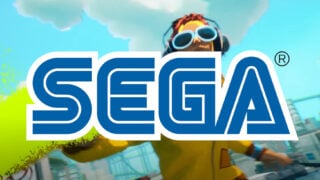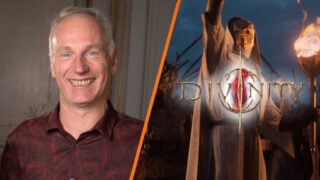Why Sega is reviving classics like Shinobi and Jet Set Radio across games, film, and TV
Transmedia boss Justin Scarpone explains how the gaming giant is planning to become an entertainment juggernaut

If you weren’t paying close attention, you could be forgiven for not noticing that Sega – best known for Sonic the Hedgehog, Persona, and Like A Dragon – has quietly become an entertainment powerhouse outside of video games.
Thanks partly to the huge success of Paramount’s Sonic movies, plus mega licensee deals with the likes of Lego and Roblox, Sega’s transmedia business has grown significantly since 2020, jumping 107 places on License Global’s Top Global Licensors list to No. 39 – above the likes of Sony Pictures. Sega says it now generates nearly $1 billion in annual retail sales of toys, clothing and merchandise alone.
Justin Scarpone – who joined Sega earlier this year following a lengthy career at Disney and others – is the company’s new global head of transmedia, whose job is now to take the success of the Sonic brand outside of video games and replicate it with Sega’s other franchises, like Persona and Like A Dragon, across film, streaming, TV, live shows, and merchandise.
Having joined the company six months ago, Scarpone arrives at a busy moment for its transmedia efforts. The company is gearing up for the release of the third Sonic the Hedgehog movie next month, and its live-action Like A Dragon series premiered on Amazon Prime last month.
Speaking to VGC at Gamescom Asia, Scarpone said he has big ambitions for Sega’s future as an entertainment company and revealed he plans to open an official Sega store in Tokyo, Japan. Potentially most exciting for older fans is the company’s initiative to bring back legacy IP like Crazy Taxi, Streets of Rage, and Jet Set Radio. Last year, the company announced multiple game revivals are in development, and confirmed film and TV projects for the likes of Eternal Champions, Golden Axe, and Shinobi.
“The strategy is to turn us into an entertainment company with games as our core pillar business, just as Disney would say films are,” Scarpone told VGC at Gamescom Asia. “We want to be in the position where it’s OK if there are people who love some of our IP who have never played a game, but have seen all of our films, been to our live shows, been to our attractions, or bought our merchandise.”
Read on for our full interview.
You’ve arrived fairly recently into the process, but what’s been your assessment on why Sega’s been so successful in its transmedia efforts recently?
I’ve been at it a little over six months now. When I worked for Disney, Sega were my licensees, so I’d had a long relationship with the executive team. But what shouted out to me after I joined as a reason why it’s grown so much [outside of video games] over the last few years were good decisions around partnerships.
That includes Paramount and Netflix, which has really allowed us to reach a broader audience. But also other things like Roblox, which has blown out our reach with younger demographics in most key territories. It’s a combination of these multiplatform approaches to getting the IP out there in the case of Sonic, which then feeds the consumer products business.
I think our core team, particularly in Burbank, who were leading that over the past five years with the film and streaming deals and driving the consumer product business for Sonic, are a key reason why we are where we are. Now I’m coming in and trying to replicate that in other territories, but also blow it out across our library of IP, which is the logical next phase.

What kind of improvements have you identified based on your experience, particularly coming from Disney?
Well, Sega traditionally is not a company that was aggressively licensing out at all, so very unlike Disney. And so you have to build the culture and the skill set of running a successful licensing business. And that starts with bringing in really talented people, giving existing team members new opportunities, and a bit of trial and error on the organization-building front.
And much of my first six months have really been focused on that because, without that, any strategies are not going to be something that you can execute. So although I think we have a clear strategic roadmap, probably 60-to-70 percent of my time in the office is about building the org across the different territories, including expanding in North America and Europe, but also getting a footprint in some of the Asian territories where our business is starting to grow very nicely, but we’re not structured yet to really maximize the transmedia opportunities.
And I would think at least for another six-to-nine months, a good share of my focus will be continuing to fill out the team, bringing in new talent from outside and also giving opportunities to talented folks within Sega who traditionally were maybe in a game studio or in marketing and trying to give them new jobs.

Sega recently broke into the top 40 global licensees list.
Yeah, I was pretty thrilled about that.
Other game publishers like Nintendo are also seeing huge gains recently as a licensing business, and PlayStation is aggressively pushing into transmedia. Do you think we’re starting to see game companies emerge as the next IP powerhouses, following toy and comic companies in previous eras?
Yeah, I think it’s the logical progression when you think about how consumers spend their time and their money. I mean, the gaming industry, as we all know, is the largest form of entertainment in the world, and the gap between games and the number two medium, which is television, is only expanding. So the growth rates are actually higher on games.
Despite the doom and gloom over the last 24 months about redundancies, and there has been some pain in the game industry, comparatively speaking, it is the primary source of entertainment in the world. And so it only stands to reason that from there, as you’re building high affinity for these core IP franchises, characters, and environments, that there will be other opportunities to tell those stories on different platforms, content, products, and services.
“I’d like to think Sega is starting to become one of the leaders among the gaming companies, but my sights are set on trying to compete with the best Hollywood studios when it comes to managing IP”
And that’s something that Disney’s done for nearly 100 years, and Warner Bros., and Universal, and others, with films as the core pillar. Our core pillar just happens to be games, and there are many other companies like Sega, like Nintendo and Sony as you mentioned, who are quite similar in that. They have their own IP, they have a very strong core fan base and community, and they can build upon that in these other channels. So I think you’ll see more, not less of that.
One thing I was going to say is that game companies are not as skilled at this yet. So in some sense they have, at this point, higher customer loyalty, certainly larger reach, but they’re not as efficient and as skilled at running these multi-pronged, transmedia businesses yet. I’d like to think Sega is starting to become one of the leaders among the gaming companies, but my sights are set on trying to compete with the best Hollywood studios when it comes to managing IP, because I think if we strive to reach that level of excellence, we should do pretty well.
On the topic of IP, Sega has so many beloved franchises on the shelf. Why has it taken so long for the company to open the vault and bring some of those back?
I don’t have a great answer, I only have my hypothesis. My hypothesis is that Sega is well-loved as a brand and as a company precisely because it’s not always succeeded. It’s had its ups and downs over the decades, and I think there was a period, particularly post-hardware Sega, where they were much more about just focusing on improving the quality of their games, getting distribution as widely as possible, and they were a true 100% game developer and publisher business.
And it’s only in the last six, seven years – and Sonic in the West was really the catalyst – that they’ve been saying, ‘OK, we’re in a good place now, and we have multiple IPs that are the top tier in terms of game franchises, how do we build upon this?’ On why they didn’t do it earlier, I think it’s a variety of factors, probably overwhelmingly driven by the state of the business at the time, which is they knew they had this plethora of IP at varying degrees of awareness and affinity, but nevertheless, more IP than most companies. And now I think we’re finally confident that we’re at a place where we can really build an entertainment company around that.
And that’s why I was hired, and hopefully, in the next few years, we’ll be able to execute against that strategy. But that is the strategy – to turn us into an entertainment company with games as our core pillar business, just as Disney would say films are. We want to be in the position where it’s OK if there are people who love some of our IP who have never played a game, but have seen all of our films, been to our live shows, been to our attractions, or bought our merchandise. Hopefully, we can get them to play games as well.
Sega is currently planning to bring back some really historic franchises across games, television, and film, like Eternal Champions, Shinobi, Comix Zone, Space Channel 5 and Crazy Taxi. Some of these IPs are nearly 30 years old, so how challenging is it to be sure that they’ll still resonate with a modern audience?
Well, to a degree, you have to reinvent them. I think there’s a core set of IPs that are currently the core pillars of our company: you have Sonic and Friends, you have Persona, you have Like a Dragon, and I would also definitely put Angry Birds in that bucket. Also, some of the things we do in Europe are quite interesting, like Football Manager, which is very stable and has a very loyal audience. Creative Assembly has Total War as well.
“We want to be in the position where it’s OK if there are people who love some of our IP who have never played a game, but have seen all of our films, been to our live shows, been to our attractions, or bought our merchandise.”
So we have these businesses where, over the next five-to-ten years, we have a persistent slate plan, marketing initiatives, product, hopefully more transmedia.
And then we have what we call the Sega Legacy IP, which is the ones you’re alluding to, that go back to the days when we were in the hardware business: arcade machines, Genesis / Mega Drive, and all that. And this is arguably the most interesting undertaking for transmedia. We just announced recently our plans to make a Shinobi film, and Eternal Champions has come out fairly recently, I believe, as well, as announced. And there are more that we’re working on.
The interesting thing about that is you have a generation of folks who remember those titles fondly from their childhood or young adulthood, who are in their 40s or 50s. And then you have a younger generation that, frankly, really doesn’t have any connectivity to that IP. So, the challenge is, if we try to reinvent these IPs, how do we connect? Which platforms and how do we evolve the lure for these IPs that are lesser known, frankly speaking? And how do we connect with new generations?
So we have a suite of titles in development right now that fall into that legacy bucket, which we announced last year at The Game Awards; Crazy Taxi, Jet Set Radio, Streets of Rage, Shinobi, and we have another Virtua Fighter being developed. And so all that’s very exciting. And then in certain instances, we’re also doing animation series, or live-action films to augment that and be part of those roadmaps.

Shinobi is a case where we both have a game and a film and planning a production is the case today. So will that resonate or not kind of depends on if we have gotten better as storytellers, and if we can reach younger audiences while also reigniting the core fans. It’s a big, big challenge.
Do you look for any particular qualities when you’re choosing which classic legacy IPs you’re going to revive?
I had the same question when I joined it, and I even asked it to [Sega America and Europe CEO] Shuji. And what I found, and he was very ardent about this point, and I think he’s absolutely right, is that the IP we’re focusing on is coming out of the passion of our creative teams. That’s both internally, and in certain instances on the film side, we’ve had screenwriters come to us and say, ‘I grew up on Shinobi, I’ve got a great story, and I want to iterate with your producers’. People have a passion for a particular IP.
So, it’s an organic process?
Yes, very much so, very much. There is, on the commercial side, the business side, if you will, there is a, ‘hey, we want to ignite this initiative’. But within what could be called legacy, we have, like, 30 IPs, right? We’re not going to do 30 films, or 30 games. So which are the ones that we are excited about? And it’s amazing how many people feel a passion for a particular IP.
We let that organically gestate over time and work with the creative folks. And once we have something, we’re like, ‘yep, we have something here, let’s go talk to a studio’. Or in the case of gaming, ‘hey, let’s do an inline process and put a cool dev team against this, then do some prototyping’.
“We have a suite of titles in development right now; Crazy Taxi, Jet Set Radio, Streets of Rage, Shinobi, and we have another Virtua Fighter being developed.”
I think that’s kind of how it happens even in Disney as well. If you go into Disney Animation or Pixar, they don’t dictate to the creators what the next story will be. They’ll say, yeah, we want another Toy Story or another Frozen, so that’s just like we want another Sonic game, right? But then there’s the area to play. So, I look at this as no different than Pixar working on a brand new original IP. Because for most consumers, that legacy IP is going to feel brand new. And we’ll see how it goes.
With Paramount’s Sonic movies, after that shaky start with the design and fan backlash, it’s been fascinating to see how the decision to then stick more closely to the source material has really resonated with the audience. So, coming from that, how important do you feel that fan-first approach is going to be for the other properties?
Critical.
You cite a very good example of the trouble we had prior to the release of the first Sonic film and how that was course-corrected and took off from there. But, to come off of Sonic for a second, I was in Taipei last week for a live concert of our Persona music catalogue, which was the first time we took the show outside of Japan, and it was just… the place was rocking.
There were so many fans that came in cosplay, we did great with merchandise sales, and it just really resonated to me that some of the things I saw at Disney, going to like Star Wars fan events or Marvel fan events at Comic-Con, you see a similar type of passion in the eyes of those core fans. And you realize how delicate it is.
I had that in Disney with Kingdom Hearts, where we were working on Kingdom Hearts 3, and we were doing fan events outside of Disneyland. It was like, we have a huge responsibility, because these people have been waiting, and they really care. And it’s an emotional thing for them, and so we need to super-serve that.

Franchises like Persona, Sonic, and Like a Dragon have that level of fandom. So bringing those people in through these events, we do fan events across the regions more and more. And talking to them, sometimes even bringing them into development sessions to get their input.
The companies that are doing that well, I think, are setting themselves up well. Because even if you maybe under-deliver on one title, the fans understand that you’re valuing them. And in this generation, teens, young adults, they’re so accustomed to that from brands that you really need to take it seriously. And usually it does make the product better.
Thank god we listened on the Sonic issue. It’s a big lesson learned. That was well before I joined, but it was one of the first meetings I had in our Burbank studio. I went there to meet the team and asked them to give me a presentation on why they’ve been so successful. And the first thing they did was present their biggest slip-up, which was that issue, how that came about and how they corrected the ship.
It was a wonderful presentation, and it gave me confidence in the team, first and foremost. However, the approach that Sega is taking has also evolved. And it’s among some of the better practices I’ve seen at Disney with how Star Wars manages the fandom.
“Thank god we listened on the Sonic issue. It’s a big lesson learned. That was well before I joined, but it was one of the first meetings I had in our Burbank studio.”
How critical is that commitment to authenticity? You touched on having to almost reinvent some of these very old IPs, like the Shinobi and stuff. How much does remaining authentic to the source material apply to those? Would you feel more confident to make sweeping changes to legacy franchises?
My very strong personal perspective on that is we need to be a little less careful and a little bit more creatively ambitious. Because the fact of the matter is that compared to these very fleshed-out at this point RPGs, like the Persona franchise or Like a Dragon, these titles go back to eras where there was very little storytelling you could actually do on those devices because of the technological limitations in an arcade machine in 1989 or a Genesis in the 90s.
So, the lore is not at the same level of detail as some of our more ‘modern’ or more recent IPs. And therefore, part of the fun of that project is really inventing the lore with some callbacks, obviously, to back in the day, if you will.
With Shinobi, for example, you have Joe Musashi, the core character, a modern-day ninja. And there are some episodic or, let’s say, iconic moments in the old franchise games that we can call out in the movie script or in the reboot of the game. But I think we have to do a lot more because games in 2025 or 2026, the level of storytelling and gameplay has just obviously evolved tremendously. If we’re too careful, I think we’ll under-deliver, creatively speaking.

Do you feel it’s important to involve the game creators in your transmedia efforts?
Oh, it is, and we do quite a bit. What we’ve structured, and this is interesting because it’s evolved over time, for example for Sonic, the formula has literally been the ‘godfather’ of Sonic, Iizuka-san, has been living in LA the last few years. And he sits right with that transmedia media team in the Burbank office. They’re not making games there: it’s the transmedia group. The games office in the US is in Irvine.
And so obviously, he goes to Irvine when they’re creating a new Sonic game, and he visits Tokyo and works with the Dev Studio in Japan, but most of the time, it’s positioning him with the transmedia folks because they’re really evolving the lore at this point.
For this new IP initiative, the Legacy series, we just brought a guy in, former Lucasfilm and Universal, who I worked with for ten years at Disney, named Hez Chorba. Hez is overseeing the transmedia evolution of the legacy series. I brought Hez in because he’s a storyteller, and he did that for Lucasfilm across games. Every Lucasfilm game in the last decade, he led creative art, all the EA stuff and Ubisoft and all that.
But also, he worked on the theme park, Galaxy’s Edge, he worked on the Disney Plus series, so he’s got a seat at the table. He was in charge of the gaming creative, and he would be on all of the transmedia stuff for Star Wars, so he knew the lore intimately. I brought him to Sega because we need to build lore for our legacy series, and we’re driving that initiative out of the US office.
“My very strong personal perspective on that is we need to be a little less careful and a little bit more creatively ambitious [with legacy franchises].”
At the same time, the games are being made in Japan, so he spent a lot of time with the EPs of each of the game titles and integrating some connective tissue between the non-games and the games. That means making sure there’s a core lore that connects to both while allowing for platform-specific freedom, if that makes sense. So, the game makers are making the games they want to make, but it has some connection to the US building.
For the other IP, Like a Dragon and Atlas, that sort of creative leadership for both transmedia and games sits in Tokyo. For those IPs, the stories are very fleshed out at this point and the creators should be in Tokyo. I have a head of transmedia for Like a Dragon, for example, and she’s flying to the US and Europe a lot to transfer the knowledge of the IP and then interpret that to make it more competitive for Western markets, working with Amazon on the series and all that, the live-action series on Amazon Prime for Like a Dragon.
How cohesive is your vision for all of those legacy franchises? Could we see something like a Sega cinematic universe? Are they going to be connected literally or philosophically?
I think the IP, the portfolio we have in general, exists in their own persistent universes. Because Marvel did it better than anybody, and I know about that because, obviously, I was there for 17 years.
But I think one of the ideas we’ve been toying with is, are there instances where you can do that? In something like the trading card businesses, where you can bring them all together, not dissimilar to what Disney’s done with Lorcana recently, where it makes sense. And you can create a game like I’ve worked on, Disney Tsum Tsum, where you bring them all together under one umbrella.

But they’re toys, and people understand it’s not the real thing, so Marvel being next to Pixar makes sense. From a consumer product standpoint, yeah, we’re going to have product lines that do that, but from a game universe standpoint, I’m not so sure that’s what fans want. I personally, creatively speaking, I’m not convinced of that.
Putting Like a Dragon with Angry Birds, the question would be, why? I think it’s a bit of a stretch. Because you don’t see Harrison Ford in a movie with Anna, and there’s a reason why. And so I don’t think in the game business, necessarily, we’ll be in that direction. But there could be maybe one Tsum Tsum-like example that we do that.
But I think it’s more probably going to be on the consumer product side. You’ll see product lines that are really sitting under the Sega brand, which is the last point I’d like to mention.
One of the core things about our transmedia team is we are really focused on elevating and strengthening the Sega brand. Because our portfolio is very broad, but the common thread is the Sega brand. Sega already has a surprising amount of fandom as a brand, and we need to look after those fans and offer new experiences to them, while putting the stamp of Sega on it more proudly.
If you go to retail today, you don’t see ‘Sega’ enough. For example, we’re opening a Sega store next summer in [Tokyo’s] Parco. There will be a Sega store. We’re also going to be doing a similar project in Shanghai, where we’ll have a store there as well via a partner.
It’s really exciting, and we need to do a lot more of that because Sega is a consumer brand that is surprisingly not in front of consumers enough. Sonic is, but Sega isn’t. That’s one of 35 things I’m working on right now!














